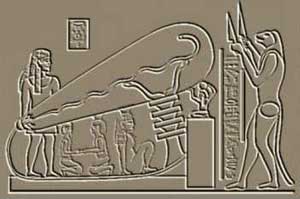|
|

by
Joseph Robert Jochmans, Lit. D. |
Walk into any modern
museum, or open any history textbook, and the picture of the past
presented is one in which humanity started from primitive
beginnings, and steadily progressed upward in the development of
culture and science. Most of the artifacts preserved in
archaeological and geological records have been neatly arranged to
fit this accepted linear view of our past.
Yet many other tantalizing bits and pieces unearthed offer a very
different story of what really happened. Called out-of-place
artifacts, they don't fit the established pattern of
prehistory, pointing back instead to the existence of advanced
civilizations before any of the known ancient cultures came into
being.
Though such discoveries with their inherent sophistication are
well-documented,
most historians would like to sweep these disturbing anomalies
under the proverbial rug. But the rug of true history is getting
very lumpy, and hard to step across without tripping over such
obvious contradictions to the conservative picture of antiquity.
What's more, the mysterious artifacts confirm ancient legends and
stories which describe human history not as linear, but cyclic.
Forgotten ages and former worlds rose and fell in great cycles of
life and death over millions of years, lost to our memory except in
myths, and now, through a few amazing pieces left to us. Here are
the top more than ten out-of-place artifacts and what they reveal to
us about our missing legacy:
1.
Baffling Batteries of Babylon
2.
The Strange
Electron Tubes from Dendera
3.
The Enigma of the Ashoka Pilar
4.
An out-of-place Computer from Antikythera
5.
Flight in Ancient Egypt
6.
A Jet from South America
7.
Crystal Skull from Atlantis
8.
Who shot the Neanderthal Man?
9.
The Incredible Stones of Dr. Cabrera
10.
Manufactured Metals Millions of Years Old
1. BAFFLING BATTERIES OF BABYLON
In 1938, Dr. Wilhelm Kong, an Austrian archaeologist rummaging
through the basement of the museum made a find that was to
drastically alter all concepts of ancient science. A 6-inch-high pot
of bright yellow clay dating back two millennia contained a cylinder
of sheet-copper 5 inches by 1.5 inches. The edge of the copper
cylinder was soldered with a 60-40 lead-tin alloy comparable to
today's best solder. The bottom of the cylinder was capped with a
crimped-in copper disk and sealed with bitumen or asphalt. Another
insulating layer of asphalt sealed the top and also held in place an
iron rod suspended into the center of the copper cylinder. The rod
showed evidence of having been corroded with acid. With a background
in mechanics, Dr. Konig
recognized this configuration was not a chance arrangement, but that
the clay pot was nothing less than an ancient electric battery.
The ancient battery in the Baghdad Museum as well as
those others which were unearthed in Iraq all date
from the Parthian Persian
occupation between 248 B.C. and A.D. 226. However, Konig found
copper vases plated with silver in the Baghdad Museum
excavated from Sumerian remains in southern Iraq dating back to at
least 2500 B.C. When the vases were lightly tapped a blue patina
or film separated from the surfaces, characteristic of silver
electroplated to copper. It would appear then that the
Persians inherited their batteries from the earliest known
civilization in the Middle East.

2. THE STRANGE ELECTRON TUBES FROM DENDERA
In different locations within the Late Ptolemaic Temple of Hathor at
Dendera in Egypt are curious wall engravings which Egyptologists
cannot explain in traditional religio-mythic terms, but about which
electrical engineers are finding very modern interpretations.
In one chamber, No. 17, the topmost panel, depicts Egyptian
priests
operating what look like oblong tubes, performing various specific
tasks. Each tube has a serpent extending its full length inside.
Swedish engineer Henry Kjellson, in his book Forvunen
Teknik (Disappeared Technology), noted that in the
hieroglyphs these serpents are translated as seref,
 which
means to glow, and believes it refers to some form of electrical
current. which
means to glow, and believes it refers to some form of electrical
current.
In the
scene, to the extreme right appears a box on top where sits an image
of the Egyptian god Atum-Ra, which identifies the box as the
energy source. Attached to the box is a braided cable which
electromagnetics engineer Alfred D. Bielek
identified as virtually an exact copy of engineering illustrations
used today for representing a bundle of conducting electrical wires.
The cable runs from the box the full length of the floor of the
picture, and terminates at both the ends and at the bases of the
tube objects. These objects each rest on a pillar called a djed,
which
Bielek identified as a high-voltage insulator.
The tube objects look very much like TV picture tubes, an impression
which is not far from wrong, for electronics technician N.
Zecharius
has identified the objects as Crookes or electron tubes,
the forerunner of the modern television tube.
Though the upper chamber scenes have been damaged by vandals from a
later age, other pictures found inside the crypt below the Holy
of Holies are almost perfectly preserved, and their portrayal
deepens the mystery of the strange electron tubes even further.
Here, not only are
the tubes shown in full operation, but something else has been
added which may suggest the ultimate purpose for the tubes
themselves. In several instances, both men and women are shown
sitting underneath the tubes, hands held out and cupped, which meant
they were in a receptive mode. What kind of radiation treatment
was being performed here?

|
